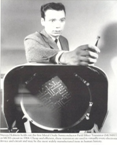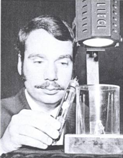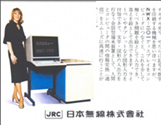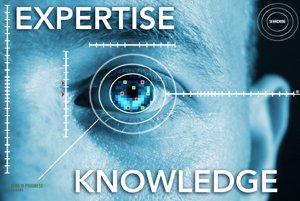DR. STEVEN HOFSTEIN'S JOURNEY
FROM METAL OXIDE SEMICONDUCTOR (MOS)
TO EXPERT SYSTEMS (ES)
Dr. Steven R. Hofstein, an internationally known scientist with over 40 patents and numerous publications, gained initial prominence through inventions that include the
Metal-Oxide-Silicon (MOS) Transistor IC - the technology that enables today's billion transistor chips, the
Lithocon silicon storage tube, and the
Liquid Crystal Display (LCD) Digital Watch. His long and successful career has been chronicled over the years by numerous publications that include the
New York Times,
Newsweek,
Business Week,
Electronic Engineering Times,
Circuit News,
U.S. Patent office, etc.
Several years ago he saw an opportunity to apply his knowledge and experience in both scientific and engineering fields towards building unique business applications utilizing Artificial Intelligence based
Expert System
technology. The result is CognasysES, a document processing software system able to replicate and automate the capabilities of highly trained human knowledge workers in almost any field.
Dr. Hofstein received his PhD from Princeton University and is the recipient of a Franklin Institute Award, one of the oldest, most prestigious, and comprehensive science and technology awards programs in the world, and was elected as a Life Fellow of that institute for his pioneering work in MOS technology.
|
|
Spurring the Technical Revolution with the MOS Transistor

Late in 1962, two young engineers working at RCA's Research Laboratory and only a few years out of college,
completed the development of the metal oxidize semiconductor (MOS) transistor nearly 50 years after the idea was first conceived by a
German physicist. The MOS transistor came to be the fundamental building block of
today's memory chips and microprocessors and for nearly 40 years, the MOS was the
mainstay of the global chip industry and was used in virtually every electronic
device and circuit.
When Dr. Hofstein first joined RCA, he was told about several project opportunities
and received some politically wise advice on the MOS transistor project. The MOS project was a "hot potato"
that had killed many careers since everyone who had tried it could not make it work;
however, if he succeeded - he would be a hero. Hofstein accepted the MOS project..
and the rest is history.
|
|
Combining the Power of Liquid Crystal Display with the MOS
 In 1965, Dr. Hofstein combined the newly developed low power liquid crystal display
with the MOS technology he pioneered to invent the Liquid Crystal Digital Watch.
In 1970, he received the basic patent
for the Liquid Crystal Digital Watch, which was assigned to RCA.
In 1965, Dr. Hofstein combined the newly developed low power liquid crystal display
with the MOS technology he pioneered to invent the Liquid Crystal Digital Watch.
In 1970, he received the basic patent
for the Liquid Crystal Digital Watch, which was assigned to RCA.
|
|
Pioneering the 1st Professional Conference in Las Vegas
 While it is widely known how Dr. Hofstein's imaging and semiconductor inventions
changed history, few may know that he also changed history, but in a much different
fashion. Hofstein founded the
Silicon Interface Specialist Conference and chose Las Vegas as the location.
This conference, which took place in 1965, was the first-ever professional conference
to be held in Las Vegas and once again.. the rest is history. (Yes, even scientists
know how to have fun!)
While it is widely known how Dr. Hofstein's imaging and semiconductor inventions
changed history, few may know that he also changed history, but in a much different
fashion. Hofstein founded the
Silicon Interface Specialist Conference and chose Las Vegas as the location.
This conference, which took place in 1965, was the first-ever professional conference
to be held in Las Vegas and once again.. the rest is history. (Yes, even scientists
know how to have fun!)
|
|
Launching the Birth of Video Imaging with the Lithocon [Electronic]
Tube

When Hofstein left RCA in 1968, he founded Princeton Electronics Products, Inc.,
and invented the
Lithocon silicon storage tube, which quickly found many uses.
- Supplying a low dosage portable x-ray system used by airports to inspect packages
that may contain bombs,
- Providing the first diagnostic quality images taken with ultrasound for medical
diagnostics.
- Storing and retrieving images of fingerprints for the FBI.
-
 Locating
and accessing library microfilm publications. Locating
and accessing library microfilm publications.
- "Frame-Snatching"
television pictures - storing, altering and playing back single TV frames continuously
over a standard TV set.
- Recording pictures of
Mars (7,300 images taken by Mariner 9 and displayed during Super Bowl Sunday
so that all across America, people witnessed this great milestone in history!).
|
|
Modernizing the Computer Graphic Industry

After his success in the scientific research industry, Dr. Hofstein focused his
efforts towards the computer industry by partnering with JRC, a Japanese organization,
to build the first-ever computer with a graphical display. The Princeton System 850 Series' architecture, designed
and built using the Lithocon storage tube, was the breakthrough in technology that
is known as the foundation for the computer-graphic industry.
|
|
Transforming the Document-Driven Business Processes
Most recently, Dr. Hofstein has dedicated his knowledge and expertise in the imaging
industry to create the first-ever
Expert System application to solve the most complex document-driven business
needs.

Founded in 1991, Cognasys LLC. developed a suite of business solutions, Cognasys
ESŪ that can emulate the reasoning and behavior of human workers who have specialized
knowledge and the training needed to solve a problem or clarify uncertainties. Expert
Systems are comprised of highly-complex technical solutions historically used by
the medical, scientific, engineering, and other similar industries.
Cognasys ES is unique in that it is the only application of its type that uses Expert
System technology for processing of business transactions.
|

